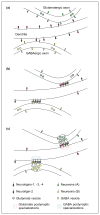How to build a central synapse: clues from cell culture
- PMID: 16337695
- PMCID: PMC2820512
- DOI: 10.1016/j.tins.2005.11.002
How to build a central synapse: clues from cell culture
Abstract
Central neurons develop and maintain molecularly distinct synaptic specializations for excitatory and inhibitory transmitters, often only microns apart on their dendritic arbor. Progress towards understanding the molecular basis of synaptogenesis has come from several recent studies using a coculture system of non-neuronal cells expressing molecules that generate presynaptic or postsynaptic "hemi-synapses" on contacting neurons. Together with molecular properties of these protein families, such studies have yielded interesting clues to how glutamatergic and GABAergic synapses are assembled. Other clues come from heterochronic cultures, manipulations of activity in subsets of neurons in a network, and of course many in vivo studies. Taking into account these data, we consider here how basic parameters of synapses--competence, placement, composition, size and longevity--might be determined.
Figures




References
-
- Katz LC, Shatz CJ. Synaptic activity and the construction of cortical circuits. Science. 1996;274:1133–1138. - PubMed
-
- Craig AM, Boudin H. Molecular heterogeneity of central synapses: afferent and target regulation. Nat Neurosci. 2001;4:569–578. - PubMed
-
- Bredt DS, Nicoll RA. AMPA receptor trafficking at excitatory synapses. Neuron. 2003;40:361–379. - PubMed
-
- Malinow R, Malenka RC. AMPA receptor trafficking and synaptic plasticity. Annu Rev Neurosci. 2002;25:103–126. - PubMed
-
- Verhage M, et al. Synaptic assembly of the brain in the absence of neurotransmitter secretion. Science. 2000;287:864–869. - PubMed
Publication types
MeSH terms
Substances
Grants and funding
LinkOut - more resources
Full Text Sources
Other Literature Sources

